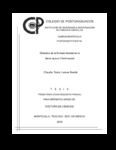Dinámica de la frontera forestal en la Sierra Ajusco Chichinautzin
Abstract
En México, se han reportado pérdidas de la cubierta forestal de hasta 1’500,000 ha/año
(Velásquez et al. 2002), el panorama en la Sierra Ajusco Chichinautzin, a pesar de
estar constituido por áreas naturales protegidas (ANP) es similar, entonces, las
preguntas obligadas ante estos hechos son, por qué si es un ANP no se ha
conservado, cómo han sido estos cambios de la cubierta forestal y qué ha provocado
esta pérdida.
Para responder el primer cuestionamiento se hizo un análisis desde el nivel local hasta
el mundial del cómo se conceptualizan las ANP y de esta manera determinar porque
esté mecanismo para conservación in situ no ha frenado la degradación de los
recursos. Para determinar la dinámica en la cubierta forestal se usaron metodologías
probadas en el área de la Teledetección espacial a través de imágenes Landsat de tres
fechas diferentes y con ayuda de un índice de vegetación (NDVI). Ahora bien, para
responder el tercer cuestionamiento, el análisis se basó en los agentes de cambio
(individuos y empresas) y en los parámetros de decisión de los agentes (los derechos
de propiedad, los decretos – las concesiones), todo ello a partir del análisis histórico en
fuentes bibliográficas - hemerográficas y con entrevistas a los agentes. Concluyendo, que la forma en la que son actualmente planteadas las ANP es la
principal causa de que estas no cumplan con su objetivo de conservar; que la
herramienta que se utilizó (imágenes Landsat) no fue la más acertada para identificar
los cambios provocados en las áreas bajo manejo forestal en la Sierra por la baja
resolución espacial, sin embargo si resultó asertiva para las zonas que no estaban
legalmente autorizadas para manejo forestal pero que sin embargo sufrieron
aprovechamiento durante la concesión por la Fabrica Loreto y Peña Pobre. Respecto a
los agentes de cambio se pudo descartar que los grupos que han habitado y habitan
actualmente la Sierra son los culpables directos de la dinámica de la cubierta forestal._________In Mexico, have reported losses of forest cover of up to 1'500,000 ha / year Velásquez
et al. (2002), the prospect in the Sierra Ajusco Chichinautzin, despite being formed by
protected natural areas (ANP) is similar, then, questions are bound to these facts, why
is an ANP has not been preserved, how they have been changes in forest cover and
what has caused this loss.
To answer the first question was an analysis from the local to the world how to
conceptualize the ANP and thus it is a mechanism for determining in situ has not
slowed the degradation of resources. To determine the dynamics in forest cover were
used methodologies in the field of space remote sensing through Landsat images from
three different dates and using a vegetation index (NDVI). But to answer the third
question, the analysis was based on the change agents (individuals and businesses)
and the parameters of decision agents (property rights, decrees - concessions), all from historical analysis in literature - and newspaper interviews with the actors. Concluding that the way in which they are now raised the ANP is the main reason that
these do not meet its objective of maintaining, that the tool was used (Landsat images)
was not more correct to identify the changes in areas under forest management in the
Sierra by the low spatial resolution, however if it was assertive in areas that were not
legally permitted for forest management but nevertheless suffered exploitation for the
provision of Loreto and Peña Pobre Paper mill. For agents of change could be ruled out
that the groups that have lived and currently live in the Sierra are the direct perpetrators
of the dynamics of forest cover.
Collections
- Tesis MC, MT, MP y DC [290]


